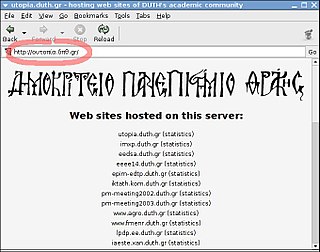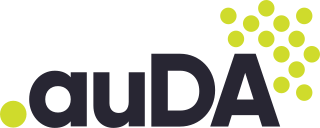
The Internet Corporation for Assigned Names and Numbers is a global multistakeholder group and nonprofit organization headquartered in the United States responsible for coordinating the maintenance and procedures of several databases related to the namespaces and numerical spaces of the Internet, ensuring the Internet's stable and secure operation. ICANN performs the actual technical maintenance work of the Central Internet Address pools and DNS root zone registries pursuant to the Internet Assigned Numbers Authority (IANA) function contract. The contract regarding the IANA stewardship functions between ICANN and the National Telecommunications and Information Administration (NTIA) of the United States Department of Commerce ended on October 1, 2016, formally transitioning the functions to the global multistakeholder community.
A top-level domain (TLD) is one of the domains at the highest level in the hierarchical Domain Name System of the Internet after the root domain. The top-level domain names are installed in the root zone of the name space. For all domains in lower levels, it is the last part of the domain name, that is, the last non-empty label of a fully qualified domain name. For example, in the domain name www.example.com, the top-level domain is .com. Responsibility for management of most top-level domains is delegated to specific organizations by the ICANN, an Internet multi-stakeholder community, which operates the Internet Assigned Numbers Authority (IANA), and is in charge of maintaining the DNS root zone.

In the Internet, a domain name is a string that identifies a realm of administrative autonomy, authority or control. Domain names are often used to identify services provided through the Internet, such as websites, email services and more. Domain names are used in various networking contexts and for application-specific naming and addressing purposes. In general, a domain name identifies a network domain or an Internet Protocol (IP) resource, such as a personal computer used to access the Internet, or a server computer.
The domain com is a top-level domain (TLD) in the Domain Name System (DNS) of the Internet. Created in the first group of Internet domains at the beginning of 1985, its name is derived from the word commercial, indicating its original intended purpose for subdomains registered by commercial organizations. Later, the domain opened for general purposes.

Verisign Inc. is an American company based in Reston, Virginia, that operates a diverse array of network infrastructure, including two of the Internet's thirteen root nameservers, the authoritative registry for the .com, .net, and .name generic top-level domains and the .cc country-code top-level domains, and the back-end systems for the .jobs and .edu sponsored top-level domains.

An internationalized domain name (IDN) is an Internet domain name that contains at least one label displayed in software applications, in whole or in part, in non-Latin script or alphabet or in the Latin alphabet-based characters with diacritics or ligatures. These writing systems are encoded by computers in multibyte Unicode. Internationalized domain names are stored in the Domain Name System (DNS) as ASCII strings using Punycode transcription.
A domain name registrar is a company that manages the reservation of Internet domain names. A domain name registrar must be accredited by a generic top-level domain (gTLD) registry or a country code top-level domain (ccTLD) registry. A registrar operates in accordance with the guidelines of the designated domain name registries.

.xxx is a sponsored top-level domain (sTLD) intended as a voluntary option for pornographic sites on the Internet. The sponsoring organization is the International Foundation for Online Responsibility (IFFOR). The registry is operated by ICM Registry LLC. The ICANN Board voted to approve the sTLD on 18 March 2011. It went into operation on 15 April 2011.
A country code top-level domain (ccTLD) is an Internet top-level domain generally used or reserved for a country, sovereign state, or dependent territory identified with a country code. All ASCII ccTLD identifiers are two letters long, and all two-letter top-level domains are ccTLDs.
Generic top-level domains (gTLDs) are one of the categories of top-level domains (TLDs) maintained by the Internet Assigned Numbers Authority (IANA) for use in the Domain Name System of the Internet. A top-level domain is the last level of every fully qualified domain name. They are called generic for historical reasons; initially, they were contrasted with country-specific TLDs in RFC 920.

The domain name mobi is a generic top-level domain (gTLD) in the Domain Name System (DNS) of the Internet. Its name is derived from the adjective mobile.
The Domain Name System of the Internet consists of a set of top-level domains that constitute the root domain of the hierarchical name space and database. In the growth of the Internet, it became desirable to expand the initial set of six generic top-level domains in 1984. As a result, new top-level domain names have been proposed for implementation by ICANN. Such proposals included a variety of models ranging from adoption of policies for unrestricted gTLDs that could be registered by anyone for any purpose, to chartered gTLDs for specialized uses by specialized organizations. In October 2000, ICANN published a list of proposals for top-level domain strings it had received.

.shop is a generic top-level domain (gTLD) launched in September 2016. Nine companies including Google, Amazon and Famous Four Media filed applications for .shop in the 2012 ICANN new gTLD application round. GMO Registry became the registry operator after prevailing in an ICANN public auction in January 2016.

.africa is the officially designated top-level domain (TLD) for the African and Pan African communities and users wherever they reside. It is a sponsored generic top-level domain (gTLD) operated by the Registry Africa. The .africa namespace is open to individuals, businesses and organizations around the world. The .africa domains are intended to showcase their brand and commitment to the African continent, establishing a home for Africa-specific products and services, expanding a brand's regional influence and acquiring online real-estate.
.music is a community-based top-level domain name (TLD) operated for the benefit of the global music community. It was one of the most highly contested new gTLDs, with eight applicants in contention.

.au Domain Administration (auDA) is the policy authority and industry self-regulatory body for the .au domain, which is the country-code top-level domain (ccTLD) for Australia. It was formed in 1999 to manage the .au ccTLD with the endorsement of the Australian Government and the authority of the Internet Corporation for Assigned Names and Numbers (ICANN). It is a not-for-profit membership organisation that promotes and protects the .au domain space.

Public Interest Registry is a not-for-profit based in Reston, Virginia, created by the Internet Society in 2002 to manage the .ORG top-level domain. It took over operation of .ORG in January 2003 and launched the .NGO and .ONG top-level domains in March 2015.
The domain name Dot Chinese Website (.中文网) is a new generic top-level domain (gTLD) in the Domain Name System (DNS) of the Internet. Dot Chinese Website is among many listed top level domains. Created along with the partner domain name Dot Chinese Online (.在线) by TLD Registry through Internet Corporation for Assigned Numbers and Names (ICANN)’s new gTLD program launched in April 28, 2014. TLD Registry was founded in June 2008 in Finland with the mission to create essential new Chinese TLDs - intended mainly towards a Chinese-speaking audience. Because it is displayed in a simplified Chinese character language specific script, Dot Chinese Website is known as an Internationalized Domain Name (IDNs).
.global is a generic top-level domain (gTLD) and was delegated to the DNS root zone on June 6, 2014. The application for the new top-level domain was approved on April 17, 2014, and .global was made available to the general public on September 9, 2014.










